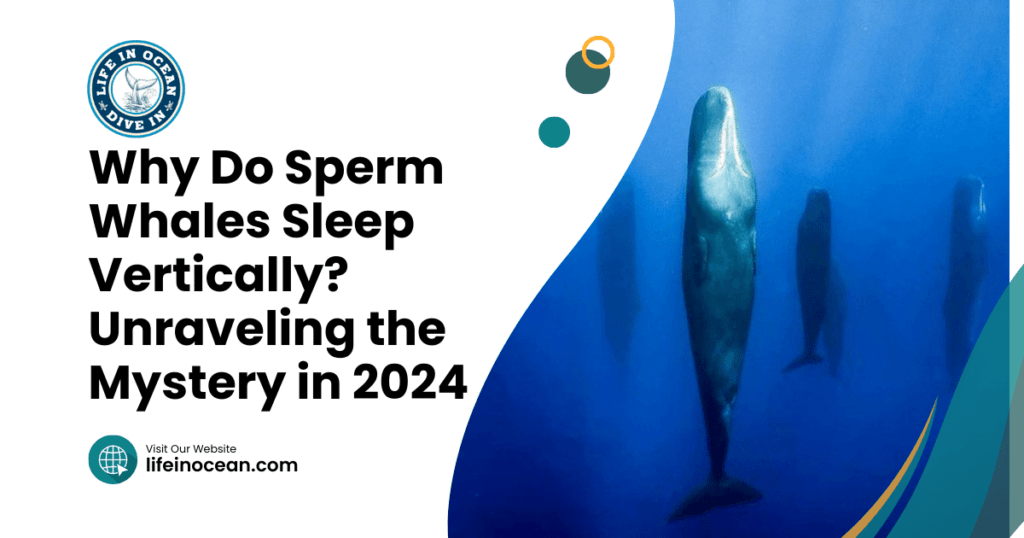Ever wondered why do sperm whales sleep vertically? These magnificent creatures have a unique sleeping behavior that sets them apart from other marine mammals. Understanding their vertical sleeping habits is crucial for conservation efforts, shedding light on the mysterious world of these ocean giants. The distinctive way in which sperm whales rest plays a significant role in their survival and behavior in the wild.
Table of Contents
Key Takeaways
- Sperm whales sleep standing up to save energy and stay safe from enemies.
- This helps them stay afloat and be ready to dive deep for food or run away from danger.
- Sleeping this way might also help them control their body temperature and stay alert while resting.
- Scientists think that this sleeping style has developed over many years, showing how well sperm whales can live in the ocean.
- Knowing why they sleep like this can help us take care of them better.
Discovery of Vertical Sleeping in Sperm Whales
Challenging Assumptions
The discovery of sperm whales sleeping vertically was a groundbreaking moment for marine biologists. It challenged the previously held assumption that all whales, including sperm whales, slept horizontally near the water’s surface. This new finding forced scientists to reconsider their understanding of whale sleep patterns and behaviors.
This unique behavior was observed by researchers studying sperm whales in the wild. They were astonished to witness these massive creatures floating upright in a state of rest. Before this discovery, it was widely believed that sperm whales either remained active throughout the day or slept while swimming horizontally.
Technological Advancements
Advanced technology has played a pivotal role in enabling scientists to study and document the elusive sleeping behaviors of sperm whales. Tools such as underwater cameras, acoustic monitoring devices, and satellite tags have provided invaluable insights into the mysterious world of these deep-sea dwellers.
With these technological advancements, researchers have been able to observe sperm whale vertical sleep patterns more closely than ever before. This has allowed them to gather data on how long these magnificent creatures remain in this unique slumber position and what physiological changes occur during vertical sleep.
- Scientists challenged assumptions about whale sleep.
- Advanced technology enabled close observation.
- Underwater cameras and acoustic devices provided valuable insights.
Vertical vs Horizontal Sleeping Behaviors in Whales

Unique Preference
Sperm whales, unlike most other whale species, have a unique preference for vertical slumber. This behavior sets them apart from their counterparts and has intrigued marine biologists for years. While other whales tend to sleep horizontally near the water’s surface, sperm whales exhibit a fascinating tendency to rest vertically in the water column.
This distinctive sleeping orientation of sperm whales has raised questions about the reasons behind this behavior and its significance in their survival and evolutionary development.
Insights into Evolutionary Adaptations
Studying the comparison between vertical and horizontal sleep patterns among different whale species provides valuable insights into their evolutionary adaptations. Understanding these variations can offer crucial information about how these magnificent creatures have evolved to thrive in their marine habitats.
The unique sleeping behavior of sperm whales sheds light on how they have adapted to life in deep ocean environments, where they spend extended periods hunting prey at great depths. By observing and analyzing these behaviors, researchers can gain a deeper understanding of how environmental factors have shaped the sleep patterns of different whale species, including the remarkable adaptation of sperm whales to rest vertically.
Buoyancy and Breath Control During Sleep
Buoyancy
Sperm whales, known for their enormous size, rely on buoyancy to sleep vertically in the water. This natural ability allows them to effortlessly float without sinking or rising too quickly. By adjusting their internal air levels, sperm whales can control their buoyancy and maintain a vertical sleeping position deep underwater.
The whale’s body is designed to manage its buoyancy through specialized adaptations. These adaptations enable the whale to regulate its depth in the ocean while conserving energy during rest. This unique feature allows sperm whales to conserve energy while they sleep, as they do not need to actively swim or tread water.
Breathing and Air Control
The ability of sperm whales to regulate their breathing even while asleep is crucial for their survival in deep waters. Their breath control mechanisms allow them to stay submerged for extended periods without needing frequent access to the surface for air.
Sperm whales possess remarkable physiological adaptations that enable them to remain submerged for up to 90 minutes at a time before resurfacing for air. These adaptations include specialized brain functions that coordinate with their respiratory system, allowing them precise control over when and how often they need to breathe.
Energy Efficiency in Vertical Resting Positions
Potential Benefits
The vertical position adopted by sperm whales during sleep offers potential energy-saving benefits compared to horizontal postures. This unique resting position suggests that these marine mammals may have developed a strategy for conserving energy while asleep. By sleeping vertically, sperm whales can remain buoyant and conserve energy by not having to swim or tread water during rest.
Sperm whales are known to spend long periods at depth, where they hunt for squid and other prey. Therefore, any opportunity to conserve energy is crucial for their survival. The vertical sleeping posture allows them to maintain their position in the water column with minimal effort, potentially reducing the amount of energy expended during sleep.
Adaptive Advantages
Understanding the relationship between energy conservation and the posture adopted during sleep is essential in comprehending the adaptive advantages of vertical slumber for sperm whales. It’s plausible that this unique sleeping behavior has evolved as an efficient way for these creatures to rest without compromising their ability to dive and hunt effectively.
Oxygen Utilization While Sleeping Upright
Efficient Oxygen Utilization
Sperm whales, known for their impressive diving abilities, also exhibit a fascinating behavior while sleeping: they do it vertically. This unique sleeping position is not just a random quirk; it’s an adaptation that allows these marine mammals to efficiently utilize oxygen while resting. By sleeping upright, sperm whales can conserve energy and minimize the effort required to breathe.
The vertical sleep cycle of sperm whales enables them to take advantage of the buoyancy provided by water. This reduces the energy needed to stay afloat and facilitates easier breathing, contributing to efficient oxygen utilization during rest. This position aligns with their natural behaviors underwater and helps in maintain stability while asleep.
Physiological Adaptations for Oxygen Management
The ability of sperm whales to manage oxygen consumption during vertical sleep is supported by various physiological adaptations. Their bodies have evolved to optimize oxygen usage, allowing them to thrive in their deep-sea environment. Understanding these adaptations sheds light on how these remarkable creatures have adapted to meet the metabolic demands associated with their unique sleep patterns.

During vertical slumber, sperm whales can regulate their oxygen consumption more effectively than if they were lying horizontally. This positioning minimizes unnecessary exertion and ensures that vital resources are utilized optimally throughout their resting period.
Safety and Predation Avoidance in Sleep
Protective Measure
Predators pose significant threats to marine mammals, including the mighty sperm whale. Sleeping vertically may serve as a protective measure against potential predators for these majestic creatures. By sleeping upright, sperm whales can remain more alert and ready to evade or defend against any approaching threats from below.
Sperm whales are known to inhabit deep ocean waters where they face various predatory challenges, making it crucial for them to adapt their sleep behavior as a means of survival. The vertical sleeping position allows them to maintain vigilance while resting, ensuring that they are prepared to respond swiftly if a predator approaches.
Predator-Prey Dynamics
Exploring safety considerations during sleep enhances our understanding of predator-prey dynamics in the marine environment. Sperm whales’ unique sleep behaviors provide valuable insights into how marine mammals have evolved strategies to mitigate predation risks while still meeting their essential rest requirements.
The evolution of such distinct sleep behaviors is closely linked with the need for survival in an environment filled with potential dangers from predators. The ability of sperm whales to adapt their sleeping patterns demonstrates the intricate balance between meeting physiological needs and mitigating predation risks in their natural habitat.
Thermoregulation and Group Cohesion in Slumber
Thermoregulation
Sperm whales, like other marine mammals, have adapted to sleep vertically to regulate their body temperature. This unique sleeping position allows them to conserve heat more effectively than if they were lying horizontally. By minimizing the surface area exposed to cold water, sperm whales can maintain a stable internal temperature during rest. This is crucial for their survival in the chilly ocean depths.
The deep-diving nature of sperm whales also contributes to the importance of thermoregulation during sleep. As they dive into colder waters for hunting, efficient heat retention becomes essential when they return to the surface for slumber. Therefore, vertical sleeping serves as an advantageous strategy for maintaining optimal body temperature throughout complex daily activities.
Group Cohesion
Interestingly, the sleeping patterns of sperm whales are not solely driven by individual physiological needs; group dynamics also play a significant role in shaping their sleep behavior. Sperm whales are highly social animals that often form cohesive groups or pods. During vertical sleep, these groups tend to maintain proximity to each other while resting.
This collective slumber may serve multiple purposes related to group cohesion and safety from predators even during sleep. The interplay between thermoregulatory needs and social behaviors influences why sperm whales opt for vertical sleeping positions as a means of ensuring both individual well-being and group security in their ocean habitat.
Duration and Patterns of Sperm Whale Sleep Cycles
Distinct Durations
Sperm whales engage in short periods of sleep, typically lasting for about 10 to 15 minutes at a time. These brief naps allow them to rest while still being able to surface for air regularly. This unique sleeping pattern is essential for their survival in the deep ocean where they spend most of their time hunting for food.
These short periods of sleep are interspersed with longer periods of activity, during which the whales hunt for squid and socialize with other members of their pod. The ability to alternate between rest and activity is crucial for maintaining energy levels and ensuring that the whales can fulfill their biological needs without interruption.
Repetitive Patterns
The repetitive nature of sperm whale sleep cycles has drawn the interest of researchers studying circadian rhythms in marine mammals. By observing these patterns, scientists gain valuable insights into how these magnificent creatures adapt to life in the open ocean. Understanding these patterns not only sheds light on the behavioral ecology of sperm whales but also contributes to our broader understanding of marine mammal biology.
Conclusion on the Vertical Sleep Mysteries of Sperm Whales
So, there you have it – the enigmatic vertical sleeping habits of sperm whales. From their remarkable buoyancy control to the energy efficiency of their resting positions, these majestic creatures continue to intrigue and fascinate. Understanding the intricacies of their vertical slumber not only sheds light on their unique adaptations but also underscores the importance of conservation efforts to protect these incredible animals and their habitats. As we delve deeper into the mysteries of the natural world, let’s remember to marvel at its wonders and strive to be responsible stewards of our environment.

Next time you catch a glimpse of the ocean, take a moment to ponder the secrets that lie beneath its surface and consider how we can contribute to preserving the awe-inspiring diversity of marine life. Embracing a sense of wonder and curiosity can inspire us to take action to safeguard the delicate balance of our oceans. Let’s embark on this journey together, championing sustainability and respect for all living beings.
Frequently Asked Questions
Why do sperm whales sleep vertically?
Sperm whales sleep vertically to conserve energy and maintain buoyancy. This position allows them to easily rise to the surface for breathing while minimizing effort during rest.
How long do sperm whales sleep?
Sperm whales have short periods of sleep lasting about 10-15 minutes at a time, which they repeat several times throughout the day.
Do sperm whales always sleep vertically?
No, sperm whales can also exhibit horizontal sleeping behaviors, especially during longer periods of rest. However, vertical sleeping is more common and offers unique advantages in terms of energy efficiency and safety.
Is it safe for sperm whales to sleep upright in the ocean?
Yes, despite being vulnerable when asleep, sperm whales are adapted to vertical sleeping as a way to avoid predators and maintain group cohesion while resting.
What role does thermoregulation play in the vertical sleeping behavior of sperm whales?
Vertical sleeping helps regulate body temperature by allowing blood flow adjustments that aid in maintaining optimal internal conditions while conserving energy.







